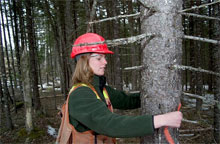
Western Crown Land - Background
Since December 2012, we have been working on a land and resource planning process for Crown land located in Western Nova Scotia (including the land purchased from Bowater Mersey Ltd.). As part of that process, people in western Nova Scotia and throughout the province were given an opportunity to provide input into the land use planning process for the 1.5 million acres of Crown land in the western region (see map of planning area).
Between March 18 and April 19, 2013 the Department of Natural Resources consulted with people of the province on how the Crown lands in the Western region should be used in the future. To view details of what we heard, click on the “Consultation Feedback” tab on the right.
The consultations have helped the department develop a conceptual plan for the management and use of the land. They provided an opportunity for Nova Scotians to give their ideas on sustainable ways to use these lands to create future economic, social and environmental gains for the western region and the whole province. Click here for the updated plan.
 Some of the land will be designated as parks, wilderness areas or nature reserves as set out in the Parks and Protected Areas Plan. Much of the land will continue to be used for forestry, but some of the land will be used for things such as agricultural operations (blueberries, cranberries etc.), mineral exploration, wineries, maple syrup production, and renewable energy. Some of the Crown land will be used for a pilot community forest project. The Department of Natural Resources is also working with the Mi'kmaq regarding a Mi'kmaw forestry initiative, also Mi'kmaw management areas. In developing the conceptual plan and more detailed management plans that will come later, the province has and will consider access to lakes, roads, and trails on the lands. People are already entitled to hunt and fish on all Crown lands, provided that those activities do not interfere with the rights of those who have leased or licensed those lands, or in areas precluded by fish and wildlife regulations. The planning for the western lands is also taking into consideration existing leases, licences, restrictions related to protected areas. All opportunities – economic, resource development, sustainable use, social, conservation, recreation, and others – are being considered.
Some of the land will be designated as parks, wilderness areas or nature reserves as set out in the Parks and Protected Areas Plan. Much of the land will continue to be used for forestry, but some of the land will be used for things such as agricultural operations (blueberries, cranberries etc.), mineral exploration, wineries, maple syrup production, and renewable energy. Some of the Crown land will be used for a pilot community forest project. The Department of Natural Resources is also working with the Mi'kmaq regarding a Mi'kmaw forestry initiative, also Mi'kmaw management areas. In developing the conceptual plan and more detailed management plans that will come later, the province has and will consider access to lakes, roads, and trails on the lands. People are already entitled to hunt and fish on all Crown lands, provided that those activities do not interfere with the rights of those who have leased or licensed those lands, or in areas precluded by fish and wildlife regulations. The planning for the western lands is also taking into consideration existing leases, licences, restrictions related to protected areas. All opportunities – economic, resource development, sustainable use, social, conservation, recreation, and others – are being considered.
The planning process has relied on the mandate of sustainable forestry management described in the province's natural resources strategy, The Path We Share, as well as all new policies and guidelines for better forest management, in line with our plans for the forestry of the future (see Thoughts on Transforming the Forest Sector)